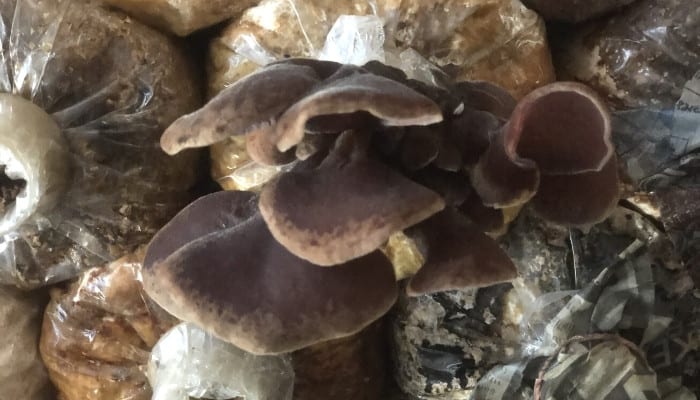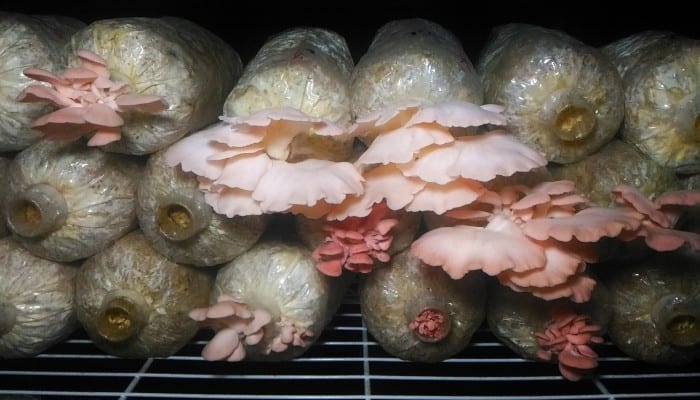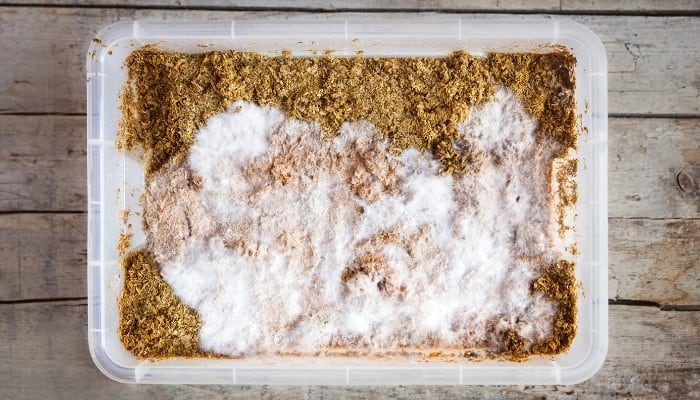If you have a fascination with growing mushrooms, it’s likely that you are familiar with the concept of a mushroom fruiting chamber.
However, if you’re like most of us, you have no idea what “mushroom fruiting chamber” really means.
What is a mushroom fruiting chamber? A mushroom fruiting chamber is an enclosed space of some type that imitates natural mushroom growing conditions. They are very successful when carefully monitored for CO2, humidity, and temperature. They can be constructed from plastic bins, repurposed mini greenhouses, or a larger modified space.
In the following, you’ll learn everything you need to know about mushroom fruiting chambers, including all the different types, how they work, and more.
Mushroom Fruiting Chambers: The Basics
Growing mushrooms indoors is a whole lot easier and the results are more assured when you use a mushroom fruiting chamber.
Instead of inoculating mason jars or planting spores on logs, growing mushrooms in fruiting chambers is much more efficient, almost guaranteeing better yields.
To use a mushroom fruiting chamber, you must set healthy mushroom culture into damp perlite in the bottom of the chamber.
Once in place, follow up with a fine misting with distilled water twice per day. Make sure the chamber gets plenty of airflow.
The main purpose of mushroom fruiting chambers is to yield superior amounts of healthy mushrooms than other methods.
Types of Mushroom Fruiting Chambers
So far, we’ve been talking about mushroom fruiting chamber basics. Now, we’re getting into the fun stuff.
There are several types of mushroom fruiting chambers. Each one has its advantages and disadvantages as well as specific environments.
Take a look at them below, and decide which one is best for you:
Monotub
Monotubs are one of the most basic types of mushroom fruiting chambers out there.
Most of them resemble large totes (because most of them ARE made out of large totes!) with air-holes drilled into the bottom of their sides.
Among the monotub’s major benefits are that it’s reusable and it holds a ton of mushrooms.
Shotgun Fruiting Chamber
The description for a shotgun fruiting chamber is very similar to the description of a monotub; it’s a big clear tote with holes drilled into the sides.
However, as much as they resemble each other, there is a difference between shotgun fruiting chambers and monotubs.
Shotgun versions have slightly more holes and use a different cultivation method than monotubs.
Greenhouse/Humidity Tent Fruiting Chambers
The “Martha” is a piece of mushroom-growing slang used to refer to a small grow room, or otherwise enclosed growing area, specially designed for mushrooms.
Marthas are basically hybrid greenhouses or grow tents with humidifiers.
These greenhouses and tent fruiting chambers may be as complex or as simple as you choose to design and build them.
Although the “Martha” is referred to generically as any small “grow room” or “grow shelf” type mushroom fruiting chamber, there are actually several various types of Martha fruiting chambers to choose from:
- Mini-greenhouse (with multiple shelves and grow areas)
- Tented plastic sheeting (over various frames)
- Wood frame (covered with tinted plastic sheeting)
- PVC frame (covered with tinted plastic sheeting)
Large Grow Room Fruiting Chamber
For those who wish to cultivate enormous amounts of mushrooms, a large grow room fruiting chamber is necessary, and the sky’s the limit when it comes to where it can be located.
A few of the best places to set up a large grow room fruiting chamber include:
- Bathrooms.
- Spare bedrooms.
- Closets.
- Shipping containers.
- Pallets.
- Storage rooms.
- Basements.
- Root cellars.
- Barns.
- Garages.
- Secret lairs (if you’ve got ‘em, use ‘em!).
Key Growing Conditions for a Mushroom Fruiting Chamber

There are several specific conditions that must be met for a successful mushroom fruiting chamber: humidity, ventilation, temperature, and lighting.
Read on below to learn more about each one.
Humidity
The humidity level of the mushroom fruiting chamber is one of the most important factors. If you get this part wrong, there is no chance your mushrooms will grow.
That’s why you should never let the humidity in your fruiting chamber drop below 80%.
How Wet Should a Fruiting Chamber Be?
The perlite in the bottom of the fruiting chamber should be thoroughly wet, to the point of almost dripping.
With around 2-3 inches of substrate and slightly more than 80% humidity, it’s just the right amount of moisture.
Ventilation
Proper ventilation is also crucial when it comes to building or operating a mushroom fruiting chamber.
Not only does the chamber need to have access to fresh air, but it will need regulated CO2 as well (higher levels at first, then lower leaves while fruiting).
There is also the question of whether or not a fan is needed. For most of us, the answer is yes. For everyone else, there are plastic tote lids and elbow grease.
Temperature
The most recommended temperature for mushroom fruiting chambers is 60°F to 65°F.
That said, depending on the level of humidity (which should be 80% or more), and the species of mushroom, the best temperature may vary.
Lighting
Although lighting is one of the four major conditions needed for a fruiting chamber to work correctly, it is the least important (except for mycelium growth) overall.
That’s because not all mushrooms require light to grow.
Most mushroom growers rely on either sunlight from windows or LED grow lights for their fruiting chambers.
When Should You Use a Mushroom Fruiting Chamber?
Anyone who has been frustrated or unsuccessful in the past with other mushroom-growing techniques should try using a mushroom fruiting chamber.
You should place your mycelium directly into the perlite in your mushroom fruiting chamber two to three days after it is completely covered in white.
Don’t forget to take the time to make sure the conditions are ripe in the fruiting chamber before transferring your mycelium.
Where To Place a Mushroom Fruiting Chamber

There are endless possibilities to where you can set up a mushroom fruiting chamber; however, the best place is somewhere with a concrete floor and preferably dark conditions.
Keep in mind that if you place a mushroom fruiting chamber somewhere with carpet, drywall, or wood, these building materials will more than likely be damaged by the humidity and wetness over time.
Also keep in mind that some sunlight is good, but you don’t want full sunlight beaming into your mushroom fruiting chamber either.
How To Set Up a Simple Mushroom Fruiting Chamber
Setting up a simple mushroom fruiting chamber is a quick and painless process.
Below, we break it down into easy-to-follow steps.
Supplies Needed
- A plastic tote with a lid
- Rubbing alcohol, vinegar, or other natural cleaning solution
- A marker
- Over a pound of perlite
- A drill
- Water
1. Sterilize Everything
No matter what type of mushroom fruiting chamber design you choose. You will definitely need to sterilize everything. No chemicals!
2. Mark Holes on Tote
Mark holes spaced out every inch or so down the sides of your tote, depending on the model you’re building.
That may include anywhere from 1 or 2 rows on the bottom to 4 or 5 rows of holes.
3. Drill Out Holes and Clean
After drilling through the container, clean any debris from the edges of the holes and inside of the tote. If necessary sterilize the container again before moving on.
4. Fill With Perlite
In the bottom of your container, place around 2-3 inches of perlite. If you’re ready to start growing right away, water the perlite until it is almost oozing.
5. Plant Mycelium To Grow/Fruit Mushrooms
Remove your mycelium from wherever you’re cultivating it (probably as cakes in mason jars) and place it straight into the perlite in the fruiting chamber.
Keep it moist by adding water via a fine mist once or twice daily.
How To Maintain a Mushroom Fruiting Chamber
Maintaining a mushroom fruiting chamber sounds a lot more complicated than it actually is.
The main things are to keep a constant watchful eye on the temperature and humidity levels (which we discussed earlier) and to mist once or twice per day until the perlite is damp.
It’s recommended to mist after any fanning for fresh air has been done to replace lost moisture.
If you want mushrooms to grow quickly and efficiently, they need a stable and well-kept environment.
Related Question:
What Triggers Mushroom Fruiting?
Mushroom fruiting is triggered by complete colonization of the substrate, decreasing levels of carbon dioxide, increasing humidity, and slight changes in light and temperature.
Once the mycelium are signaled that it’s time to fruit, you’ll see primordia forming, which is the beginning of pinning or the mushroom fruiting stage.
Final Thoughts
Mushroom fruiting chambers are a great way to get into growing mushrooms on any scale.
Whether starting with a monotub or a complex underground network of grow rooms, a well-made mushroom fruiting chamber can produce larger yields than good old mother nature does on her own.

